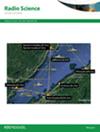A novel single DVCCTA based electronically tunable, wideband, four-mode instrumentation amplifier
IF 1.5
4区 地球科学
Q3 ASTRONOMY & ASTROPHYSICS
引用次数: 0
Abstract
This paper describes a new instrumentation amplifier (IA) that has the ability to operate in all four possible modes: voltage, current, transimpedance, and transadmittance mode using a single Differential Voltage Current Conveyor Transconductance Amplifier (DVCCTA) along with external grounded resistors. The suggested IA structures offer a broad range of common mode rejection ratio bandwidth (BW) and differential gain (A一种新型的基于单DVCCTA的电子可调谐宽带四模仪表放大器
本文介绍了一种新的仪表放大器(IA),它能够在所有四种可能的模式下工作:电压,电流,跨阻和跨导纳模式,使用单个差分电压电流传送带跨导放大器(DVCCTA)以及外部接地电阻。建议的IA结构提供宽范围的共模抑制比带宽(BW)和差分增益(Adm)带宽,分别为电压模式(18.7 MHz, 26 MHz),电流模式(17.29 MHz, 1.05 GHz),跨阻模式(25.25 MHz, 168 MHz)和跨导纳模式(17.29 MHz, 1.05 GHz),其中未报道的1.05 GHz增益BW的发现强调了设计的独特性。此外,由于可用的接地无源属性,它们适用于IC集成。此外,该设计还具有一个有趣的功能,即通过偏置电流(IB)对增益进行电子调谐,并且功耗低。DVCCTA的实现采用20MOS晶体管,采用0.18 μm TSMC CMOS技术参数的OrCAD PSPICE验证了所提出的IA电路的可操作性。通过考虑DVCCTA的非理想性,分析了所建议拓扑的性能。除此之外,还描述了工艺、电压、温度相关变化和蒙特卡罗模拟,以验证所提出的设计。电路的功能也通过实际实验得到验证,采用商业上可获得的电流反馈运算放大器,如ICAD844和后布局仿真。仿真结果与理论预测吻合较好。
本文章由计算机程序翻译,如有差异,请以英文原文为准。
求助全文
约1分钟内获得全文
求助全文
来源期刊

Radio Science
工程技术-地球化学与地球物理
CiteScore
3.30
自引率
12.50%
发文量
112
审稿时长
1 months
期刊介绍:
Radio Science (RDS) publishes original scientific contributions on radio-frequency electromagnetic-propagation and its applications. Contributions covering measurement, modelling, prediction and forecasting techniques pertinent to fields and waves - including antennas, signals and systems, the terrestrial and space environment and radio propagation problems in radio astronomy - are welcome. Contributions may address propagation through, interaction with, and remote sensing of structures, geophysical media, plasmas, and materials, as well as the application of radio frequency electromagnetic techniques to remote sensing of the Earth and other bodies in the solar system.
 求助内容:
求助内容: 应助结果提醒方式:
应助结果提醒方式:


